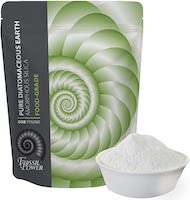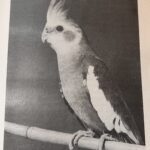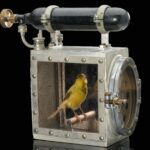
Diatomaceous earth and parrots
What is diatomaceous earth?
For this article, I’m leaning heavily on a very concise and clearly worded fact sheet from the National Pesticide Information Center (NPIC). This organization is a collaboration between the Environmental Protection Agency and Oregon State University and receives funding from no other sources.
Rather than describe what diatomaceous earth is, I’ll defer to NPIC.
Diatomaceous earth is made from the fossilized remains of tiny, aquatic organisms called diatoms. Their skeletons are made of a natural substance called silica. Over a long period of time, diatoms accumulated in the sediment of rivers, streams, lakes, and oceans. Today, silica deposits are mined from these areas.
Diatomaceous earth is not poisonous; it does not have to be eaten in order to be effective. Diatomaceous earth causes insects to dry out and die by absorbing the oils and fats from the cuticle of the insect’s exoskeleton. Its sharp edges are abrasive, speeding up the process. It remains effective as long as it is kept dry and undisturbed.Diatomaceous earth products are registered for use against bed bugs, cockroaches, crickets, fleas, ticks, spiders, and many other pests.
The first pesticide products containing silicon dioxide (diatomaceous earth) were registered in 1960 to kill insects and mites.
Diatomaceous Earth—General Fact Sheet—National Pesticide Information Center
What does conventional wisdom say?
A search for diatomaceous earth reveals the internet conventional wisdom to be quite negative.
Breathing DE is a really really really bad idea for everyone across the board (including you and other pets), and super bad for parrots.
I personally don’t trust any powder form of anything around my birds… why risk it?
I would not use something as dusty as DE, even if it isn’t filled with silica, around parrots with their sensitive respiratory system.
Well, it’s harmful if breathed in by people, so I assume it would be harmful to be breathed in by birds. Would probably tear their air sacs.
Diatomaceous earth causes insects to dry out and die by absorbing the oils and fats from the cuticle of the insect’s exoskeleton. Its sharp edges are abrasive, speeding up the process. If it can do that to a bug, what is it going to do to the inside of a bird?
If one believes DE is cutting up worms in the gut, as some claim, one must also believe that DE is cutting up the digestive tract, delicate eye tissues and the respiratory system of a chicken when airborne.
That took less than 5 minutes to find these excerpts and many of them are on mainstream and generally trusted websites. It’s a shame that people just “parrot” these opinions without researching it further. This is especially sad because there are almost no pesticides that don’t rely on toxic chemicals to work so diatomaceous earth is a rare product that can be safe and extremely effective.
What does the research say?
Before returning to NPIC, I’ll summarize what the research says about the safety of applying diatomaceous earth: nothing at all.
In research article after article, animals are drinking, eating, and being doused with diatomaceous earth directly and ill effects to humans or animals aren’t even mentioned. Here are a few example sources:
- Effect of diatomaceous earth on parasite load, egg production, and egg quality of free-range organic laying hens—Poultry Science—July 2011
- Mites of Poultry—Merck Veterinary Manual
- Effect of diatomaceous earth as an anthelmintic treatment on internal parasites and feedlot performance of beef steers—Animal Science
Note that none of these mention parrots. Diatomaceous earth has not been specifically researched for parrots, but neither has any pesticide or household cleaner. Also, all avian species share a similar respiratory system, which has been shown to not always be as sensitive as people think it is.
There is also not a single documented case of an adverse reaction from diatomaceous earth from a parrot or any bird species. Sometimes lack of research can be confirming, especially for a product that’s been on the market for 59 years.
And finally, if you think the USDA has any credibility, they’ve approved it for use in animal feed. I don’t trust the USDA, but for an agency that’s essentially owned by industry, you have to sit up and take notice when they are recommending an alternative pesticide.
What are the risks?
I’ll return to the National Pesticide Information Center to comment on the risks.
If breathed in, diatomaceous earth can irritate the nose and nasal passages. If an extremely large amount is inhaled, people may cough and have shortness of breath. On skin, it can cause irritation and dryness. Diatomaceous earth may also irritate the eyes, due to its abrasive nature. Any dust, including silica, can be irritating to the eyes.
After inhalation of amorphous diatomaceous earth, it is rapidly eliminated from lung tissue. However, crystalline diatomaceous earth is much smaller, and it may accumulate in lung tissue and lymph nodes. Very low levels of crystalline diatomaceous earth may be found in [human grade] pesticide products.
When mice were forced to breathe diatomaceous earth for one hour each day for a year, there was an increase in lung cancers. When rats were fed silica at a high dose for two years, there was no increase in cancer development.
Most diatomaceous earth is made of amorphous silicon dioxide [labeled as human grade]. However, it can contain very low levels of crystalline silicon dioxide. Amorphous diatomaceous earth has not been associated with any cancers in people.
In a rabbit study, researchers found no health effects after applying diatomaceous earth to the rabbits’ skin five times per week for three weeks. In a rat study, researchers fed rats high doses of diatomaceous earth for six months. They found no reproductive or developmental effects. In another rat study, the only effect was more rapid weight gain. That study involved 90 days of feeding rats with a diet made of 5% diatomaceous earth.
When guinea pigs were forced to breathe air containing diatomaceous earth for 2 years, there was slightly more connective tissue in their lungs. When researchers checked before the 2-year mark, no effects were found.Diatomaceous Earth—General Fact Sheet—National Pesticide Information Center
A very small amount of crystalline diatomaceous earth may be found in pesticide products [human grade]. Long-term inhalation of the crystalline form is associated with silicosis, chronic bronchitis, and other respiratory problems. The bulk of diatomaceous earth is amorphous, not crystalline. The amorphous form is only associated with mild, reversible lung inflammation.
So, all those quotes are nice, but I don’t see birds mentioned. Here’s what they have to say:
It is commonly encountered by birds and other wildlife, and it’s not known to be harmful. Agencies have stated that diatomaceous earth is unlikely to affect birds, fish, or other wildlife in a harmful way.
Diatomaceous Earth—General Fact Sheet—National Pesticide Information Center
Note that it’s important to buy food grade diatomaceous earth, which is predominanty the amorphous type mentioned in the quotes above. Also, consider getting a mask and safety goggles to minimize the irritation. There may never be a need to apply to a bird directly, so it couldn’t hurt to keep a bird away until the dust settles.
Is there a better way to use it?
There’s a less known method to apply diatomaceous earth called wet application. Quite simply, you mix some diatomaceous earth (I use 2 Tbsp per liter based on experimentation) and spray it. This eliminates the dust problem. Once the application area dries, the diatomaceous earth starts to take effect.
This technique is almost exclusively mentioned by gardeners and there is frequent mention of wettable powders in research papers.
However, a simple Google search will find many examples of people using it in their gardens successfully. Worst case scenario, you’ve sprayed slightly cloudy water on your plants. I use this method in my aviary, spraying diatomaceous earth with some thyme oil (a subject for a future article) on a weekly basis.
What about outdoor aviaries?
Note that even though diatomaceous earth can get wet and regain its potency when dry, rain and watering will wash it away. So, in an outdoor aviary, you may have to re-apply frequently and possibly give up in the winter if you have sections that are not covered by a roof.
Want to read more?
If you want to become the world’s expert on diatomaceous earth, the NPIC has an extensive bibliography for your perusal.




